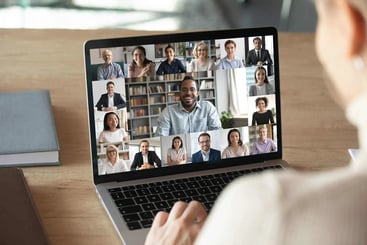Prepare For the Worst with the Best in the Business
Experience capable, consistent, and easy-to-use business continuity management software.
Every organization that plans to bring employees back to the workplace while the COVID-19 pandemic persists will need to form a return-to-work team. In today’s post we’ll look at the seven most important roles on the team and discuss the tasks that must be handled by each.
The recent resurgence in the number of new COVID-19 cases has thrown organizations across the country into limbo with respect to their reopening plans. However, most organizations will be looking to bring staff back to work at the central location as conditions permit, with the percentages varying by organization and over time. Others are leaving many of their people working from home for the foreseeable future or, in some cases, permanently.
FORMING A RETURN-TO-WORK TEAM
Before bringing employees back, many if not most organizations will find it beneficial to form a return-to-work team to manage the various aspects of the transition. These include things most companies have never had to worry about before, such as taking employees’ temperatures, redesigning the workplace to enable social distancing, and knowing what to do if COVID-19 cases at a reopened workplace suddenly spike.
For companies that already have a crisis management team, the natural choice would be to make it the return-to-work team. Other organizations might need to form a return-to-work team ad hoc.
Regardless of how your return-to-work team comes to be assembled, there are seven roles on the team that will be of special importance. Below is a list of those roles and the most important responsibilities of each.
TEAM LEADER
The role of leading the return-to-work team is similar to that of being the leader of a crisis management team, a subject my co-author Richard Long and I discussed in our recent ebook, Crisis Management: A Handbook for BCM Professionals (see Chapter 3, “Staffing the Crisis Management Team”). Check out the ebook (free for download) to learn about the responsibilities of a CMT leader and the qualities it takes to excel at the job—information also applicable to being the leader of a return-to-work team.
SENIOR MANAGEMENT
The key responsibility of senior management with respect to the return to work team is determining who should continue working at home, who should remain on furlough, and who should return to the workplace—and when. The return should be phased. Bringing people back has costs and benefits. Top managers are advised to base their decision-making on the company’s BIA, which already established the relative importance of the various business unit processes.
Another factor is how the various departments are doing with working at home. For some departments, working at home is not feasible. Others might have struggled to be productive. Others might have adapted easily. After analyzing the above issues, senior management has to decide who it wants to bring back and on what timetable, while balancing the feasibility of remote work with public health risks.
FACILITIES
The Facilities department truly has a heavy burden and high responsibility when it comes to helping the organization return to work amid the continuing threat from COVID-19. At most organizations, Facilities will be responsible for controlling the flow of employees and visitors into the facility, questioning them to evaluate their COVID-19 risk, taking people’s temperatures, and maintaining a quarantine room to house individuals who are found to be running a fever.
The Facilities person on the return-to-work team will also be in charge of reshaping the workplace to ensure it meets legal requirements and follows CDC recommendations. This includes such tasks as spreading out workstations, putting up plastic shields, establishing and following cleaning protocols, training janitorial staff, installing equipment such as UV disinfectors, and posting signs to facilitate social distancing. The CDC has excellent guidelines laying out the type of adaptations and cleaning needed at different kinds of workplaces (plant, office, school, etc.). The Facilities person should also ensure the organization can provide an emergency deep cleaning if a cluster of people at the facility test positive for COVID-19.
SECURITY
Security should assist Facilities in controlling access to the organization’s buildings. They should be prepared to step in if an employee resists being denied entry because of a high temperature. Security could also assist in contact tracing and in maintaining lists of people who enter the facility each day.
HUMAN RESOURCES
The Human Resources person on the return-to-work team will have his or her hands full. Among the HR issues to be managed are: devising policies and procedures pertaining to COVID-19, conducting training for employees who are coming back to work regarding the things they are expected to do to help keep themselves and others safe (wear a mask, keep six feet away from others, etc.), getting people engaged in their jobs again, and managing the unusual personnel issues that are likely to come up in connection with the pandemic (employees who are desperate to come back to the office, employees who prefer to keep working from home, etc.).
COMMUNICATIONS
The mainjob of the Communications person on the return-to-work team will be making sure the guidelines and information developed by HR and Facilities are well-written, packaged in a way that makes it clear it comes from the company, and regularly communicated to employees throughout the return to work process.
LEGAL
With respect to the return-to-work team, the Legal team member’s job will center on knowing the relevant rules and regulations from OSHA, ADA, the EOCC, and so on, and making sure Facilities and HR are following them, in order to minimize the company’s legal exposure in the event people connected with the organization become ill with COVID-19 and/or at odds with the policies and procedures required to maintain a safe workplace.
ONE TEAM, SEVEN ROLES
The resurgence of COVID-19 has added an element of uncertainty to the reopening plans of many organizations. One area where there is no uncertainty is in the benefits of forming a return-to-work team. Every organization that is eventually planning to reopen or bring workers back together in centralized facilities would be wise to form such a team to help manage the various aspects of the transition. On this team, seven roles will be especially important: team leader, senior management, facilities, security, human resources, communications, and legal.

Michael Herrera
Michael Herrera is the Chief Executive Officer (CEO) of MHA. In his role, Michael provides global leadership to the entire set of industry practices and horizontal capabilities within MHA. Under his leadership, MHA has become a leading provider of Business Continuity and Disaster Recovery services to organizations on a global level. He is also the founder of BCMMETRICS, a leading cloud based tool designed to assess business continuity compliance and residual risk. Michael is a well-known and sought after speaker on Business Continuity issues at local and national contingency planner chapter meetings and conferences. Prior to founding MHA, he was a Regional VP for Bank of America, where he was responsible for Business Continuity across the southwest region.
.png)
.png)


